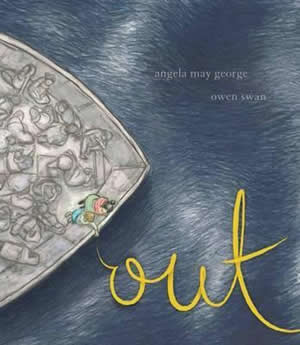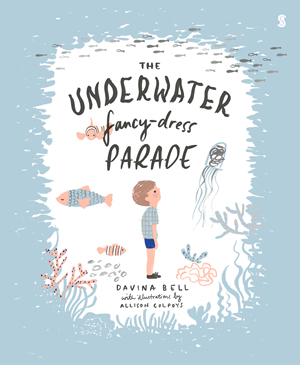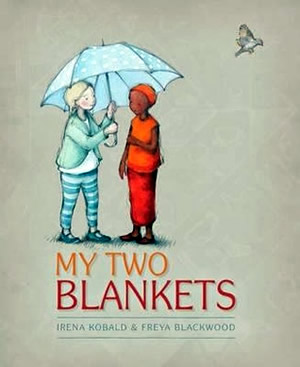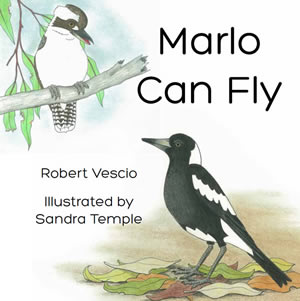Tintinnabula By Margo Lanagan and Rovina Cai, Little Hare, 2017. ‘In wild times and in wartime, in times of fear and illness, I go to Tintinnabula, where soft rains fall.’ The landscape is barren and bleak, with skeletal trees bending to the elements. Rain slices down on the ruins of a building; the chiaroscuro of shadows adding depth to the desolate. A small figure approaches a large opening in the ruins leading to nowhere…or is it? Tintinnabula opens with dark and frightening creatures dominating the small figure of a girl in the bottom corner of the page. They could be inner demons or outer demons. They are very visible though. The illustrations are haunting and emotive and move directionally through the pages. The girl running, tearing, in an effort to be free of the demons on her tail. Always, there is a glimpse of a lighter place, a safer place, but it is far from an immediate reach. And still, the demons come. A feather. A whisp. The faceless character runs through pages following a white bird, until we finally meet her face-to-face, when she arrives in Tintinnabula. The overall colour palette changes from dark and red, to light and…
Out By Angela May George and Owen Swan, Scholastic Press, 2016. I’m called an asylum seeker, but that’s not my name. Out is the moving story of a little girl and her mother who have fled from danger in their homeland. They travel by boat on a long and perilous journey to seek asylum in a new and safe land. This story is timely and celebrates how the human spirit can triumph even through the darkest times. The little girl and her mother build a new life and await the arrival of the little girl’s father at the end of the story. Awards Shortlisted: The Picture Book of the Year by Children’s Book Council of Australia, 2017.
The Underwater Fancy-Dress Parade By Davina Bell and Allison Colpoys, Scribe Publications, 2015. Sometimes it’s hard to be brave. Sometimes you get that feeling. Sometimes you’re just not ready… until, one day, you are. What do you do when you don’t want to do something? On the first page, we meet Alfie. Alfie looks sad and down, and his head and shoulders are slumped. His toy rabbit is slumped on the shelf. Even his sweater hangs mournfully from the chest of drawers. Alfie’s got that feeling. He knows that feeling, that familiar feeling, that not nice feeling. He’s even had bad dreams about feeling trapped and carrying the weight of the world on his shoulders again. Too shy for friends, Alfie confides in the cowboys on his wallpaper. To help Alfie become brave about going to an oceanic fancy-dress party, his mother takes him on a special day out to the aquarium. There Alfie meets a little clownfish. Perhaps because the clownfish was hiding when Alfie spotted him, it reminded him of how he feels sometimes. His mum explains to him that sometimes fish just hide away too. I think this makes it ok for Alfie to feel this way too. The…
My Two Blankets By Irena Kobald and Freya Blackwood, Little Hare, 2014. ‘Cartwheel has moved to a place that is so strange to her, she no longer feels like herself. This is a story about new ways of speaking, new ways of living, new ways of being.’ In My Two Blankets, we travel with Cartwheel across countries to a new world far from the world she grew up in and is familiar with. She feels isolated and alone, and goes home and hides under her old blanket, where she feels safe. She mentions that when she went out, it felt like she was ‘standing under a waterfall of strange sounds. The waterfall was cold. It made me feel alone.’ Her old blanket is adorned with familiar objects from her homeland. Then, one day when she is in the park, she makes a friend. Her new friend begins to teach her new words, and as Cartwheel grapples with her new language, she doesn’t feel so much like she is under a waterfall anymore. She soon begins to weave herself a new blanket encapsulating the words and images of her newfound language. And, as she learned the new words she ‘whispered them…
Marlo Can Fly By Robert Vescio and Sandra Temple, Wombat Books, 2013. Everyone expects Marlo to fly, but she would rather slither like a snake, hop like a kangaroo and swim like a crocodile. But when someone needs her help, can she still rise to the challenge? I don’t know about you, but I love a magpie…and what a delightful little magpie story this is. Marlo Can Fly is about Marlo Magpie, a little bird who just wanted to be different. Marlo thinks she doesn’t need to fly like the other birds, so instead she sings through the forest. Marlo really wants to be different. Kandy the kookaburra tries to explain that Marlo is a bird, and birds fly…it’s just what they do. Marlo meets several Australian animals and reptiles in the bush and tries to mimic their movements, but fails each time. Then she meets Kev the baby koala who has lost his mother and really needs Marlo’s help. How does Marlo help little Kev? Read Marlo Can Fly and find out! This story encourages kids to explore and discover themselves to find out who they really are and where they fit in this world.






